#Japanese Battleship Kongo
Text

Japanese Battleship Kongō (金剛, Mount Kongō) is bracketed by 1,000 lb. bombs during an air strike on the Japanese task force off Panay Island, Philippines.
Photographed on October 26, 1944.
NARA: 193802518
#Japanese Battleship Kongō#Kongō#Japanese Battleship Kongo#Kongo#Kongo Class#Japanese Battleship#Battleship#warship#ship#boat#October#1944#Imperial Japanese Navy#IJN#World War II#World War 2#WWII#WW2#History#WWII History#my post#Kongō Class
53 notes
·
View notes
Text
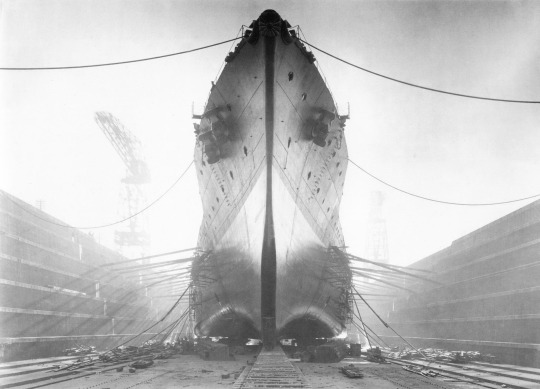
Le cuirassé Kongo de la Marine Impériale japonaise en cale sèche lors de la 1ère refonte du navire – Yokosuka – Japon – 1930
Le croiseur de bataille Kongo est entièrement refondu de septembre 1929 à mars 1931. A la sortie du chantier naval le 31 mars 1931 le navire est reclassé en cuirassé.

#WWII#avant-guerre#pre-war#marine impériale japonaise#imperial japanese navy#ijn#cuirassé#battleship#classe kongo#kongo-class#kongo#croiseur de bataille#battlecruiser#yokosuka#japon#japan#1930
11 notes
·
View notes
Text

The Japanese battleship Haruna conducting trials following her major reconstruction in 1934.
During her reconstruction, Haruna took on enough additional weaponry, armor, and other equipment that it required adding blisters to her hull (improving her stability while also increasing her protection against underwater threats). This led to an increase in her displacement by roughly 5,000 long tons. Her standard displacement grew from 27,500 long tons to 32,200 long tons. Her new full load displacement grew to roughly 36,600 long tons.
Despite the increase in tonnage and the widening of the beam from 92' (28m) to a new maximum of 101' 8" (31m), the speed of Haruna actually increased. This was due to a new powerplant, her sixteen coal-fired boilers (the result of a 1920s modernization that replaced her original thirty-six boilers) being replaced by eleven brand-new oil-fired models. This doubled her power from 64,000shp (her original output) to a new maximum of 136,000shp. The increase in power was also helped by grafting a new stern section to the hull, increasing her length by 26' (7.8m) and helping maintain her length-to-beam ratio even with the new blisters. This was enough to permit a new maximum speed of just over 30 knots.
Now, a lot of people would say this was all for naught, considering the armor was still relatively light by battleship standards. This certainly showed itself to be a problem when Kirishima was destroyed by American battleships. On the other hand, the Kongo class were far more likely to meet enemy destroyers or cruisers in combat. In this regard, the armor was sufficient.
I would go so far to say that the Kongo class were the most useful battleships in the Japanese Navy during World War 2. Their speed made them far more flexible and able to undertake a greater variety of roles.
The only major weakness of the rebuilt Kongo class was their lack of a truly modern anti-aircraft weapon system. Of course, this was a problem that affected Japan as a whole. Had the Kongo class had access to some improved anti-aircraft weapons, perhaps the 100mm heavy anti-aircraft weapons, they would have proved to be even better escorts in fleet actions.
21 notes
·
View notes
Text

Japanese aircraft carrier Taiho at anchor, probably at Tawi-Tawi, Philippines. In the background are a Shokaku-class carrier and a Kongo-class battleship
23 notes
·
View notes
Photo

“The Stage Is Set" As promised: our big post we hinted about yesterday, and it will be in two parts. 80 Years Ago - (Sunday) Nov 15th, 1942: For all the insanity happening in the Atlantic and North Africa, half a world away in the Solomon Islands, the island of Guadalcanal – and the waters around it – have become ground zero. It is the opening stage of the ground offensive to retake the Pacific, and men, supplies, planes, and ships from both sides are being hurled into it. Neither side can afford to lose it, and efforts from the Americans and the Imperial Japanese are exceeding beyond maximum. The day of the Battleship is waning, but that doesn’t mean that several dozen of these steel monsters still patrol the seas with their massive guns. Eclipsed by the aircraft carrier, the battlewagons still have plenty of life – and lethality – left in them. The Naval Battle Of Guadalcanal started on November 12th. I don’t have enough room in a hundred posts to cover it all, other than it is a wild, and horrifically savage fight that involves everything from destroyers to battleships. Both sides have been chewing away at each other for two days with no clear winner. The stage is set for one violent, brutal climax. Steaming in comes US Navy Task Force 54, with 6 ships, under Admiral Willis A. Lee. It comprises the battleships USS Washington (BB-56, North Carolina-Class, Photo 1) and USS South Dakota (BB-57, South Dakota-Class, Pic 2) and an escort of four destroyers: USS Walke, Preston, Benhim, and Gwin, respectively. Heading straight for them in the pitch dark is a Japanese task force under Admiral Nobutake Kondō. It has FOURTEEN ships: the battleship Kirishima (Kongo-Class, Photo 3), 2 heavy and 2 light cruisers and 9 destroyers. At less than 10 miles from one another, the battle opens. In short order, all four American destroyers are sunk or knocked out; Washington knocks out one Japanese destroyer. Things go right out the window when South Dakota suffers a catastrophic electric failure; she loses her radios, radar, and firing capability. Spotlighting her, the Japanese tear into South Dakota rake her with fire. Washington is now on her own. Stand by for Part 2! (at Fort Hancock, New Jersey) https://www.instagram.com/p/ClDBerItt8K/?igshid=NGJjMDIxMWI=
6 notes
·
View notes
Text
Fuso Class Battleship - Imperial Japanese Navy
Fuso Class Battleship – Imperial Japanese Navy
At the time of their launching, the two were the most heavily armed battleships in existence and were designed to operate with the Kongo Class. Fuso and Yamashiro underwent extensive refits: one in the twenties, one in the thirties.
Time and resources devoted to modernization might have been better utilized elsewhere but the Washington Naval Treaty limited new builds and at that point the…
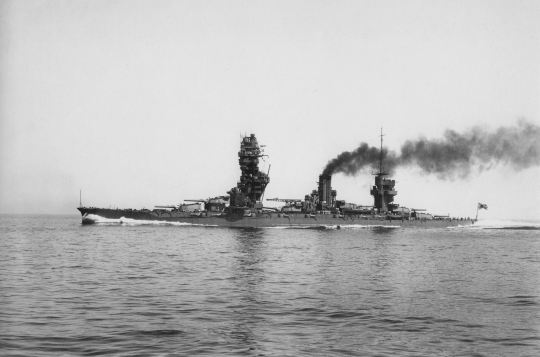
View On WordPress
1 note
·
View note
Photo

Major caliber naval guns of the Imperial Japanese Navy.
From the bottom:
>30 cm/45 (12") Type 30: One of the first guns used by the IJN and equipped the first series of pre-dreadnoughts. Based on British designs, these were the first large-caliber weapons manufactured in Japan. Famously used on the Mikasa.
>36 cm/45 (14") Type 36 cm: Again based on British designs, these were the guns used on the Kongo, Fuso, and Ise-class battleships.
>40 cm/45 (16.1") Type 40: The first large-caliber guns designed entirely in Japan. Were used on the Nagato-class and were planned to be used on most ships of the 8-8 fleet.
>40(46) cm/45 (18.1") Type 94: You all know it, the most powerful gun to ever sail the seas. Were officially designated as 16" guns since they were massive treaty violations. Only used on the Yamato-class.
>36(48) cm/45 (18.9") Type 36: Again mis-designated to avoid drawing attention from foreign Navies, these guns were first designed in the 20s before being abandoned when the Washington treaty banned guns >16". Were re-visted in the 30s to form the basis for the 46cm guns the Yamato-class used. Only test-fired.
>51 cm/45 (20.1"): Absurdly large guns planned for the largest class of Japanese battleship: the A-150. Could also be used to upgun a Yamato by swapping the triple 18.1" turret for a twin 20.1" turret. Construction halted at the start of the Pacific War with only one gun completed.
4 notes
·
View notes
Quote
Mighty Haruna and Kongo had steamed down from Rabaul. Cruisers and destroyers came with them, some to join the airfield bombardment, others to protect seven transports loaded with General Maruyama’s remaining troops. They slid into the bay, screened by cruiser Isuzu and eight destroyers.
They awaited the flares of the ground troops, the patrol plane’s green light. Then:
“Commence firing!”
Star shells rose, horrible and bright, scarlet with the fat red beauty of Hell, exploding like giant ferris wheels to shower the night with streamers of light. And then, the 14-inchers of the battleships, the eight-inchers of Isuzu, the five-inchers of the destroyers ... Pah-boom, pah-boom. Pah-boom, pah-boom, pah
Men in their holes could hear the soft hollow thumping of the salvos to seaward, see the flashes shimmering outside the gun ports, and then the great airy boxcars rumbling overhead, wailing and straining—hwoo-hwooee—seeming to lose breath directly overhead, to pause, whisper, and go on. Then the triple tearing crash of the detonating shells and the bucking and rearing of the very ground beneath them.
American troops had never before been exposed to such cannonading and would never be so again.
Even the great naval shellings that would one day fall upon the Japanese would not be comparable, for the Japanese would be in coral caves or huge pillboxes of ferro-concrete, while these Americans crouched in dirt holes, within shelters of mud and logs.
Henderson Field’s bombers were blown to bits, set afire, crushed beneath collapsed revetments. Shelters shivered, sighed and came apart. Foxholes buried their occupants. Men were killed—41 of them, among them many pilots—and many, many more men were wounded.
But the over-all effect upon men’s souls was devastating. In that cataclysm, when every shell seemed to explode with the pent-up flame and fury of a full thunderstorm, some men might glance at their buddies and see in horror how their features had dissolved in a nerveless idiot mask.
Men whimpered aloud. Others burst into sobs and rushed from the pits rather than betray their weakness, if such it was, before comrades. There were Marines who put their weapons to their heads. Men prayed with lips moving silently across the backs of others against whom they lay huddled, prayed in confusion —mentally murmuring Grace or a childhood refrain as though it were the Lord’s Prayer—prayed for the strength to stay where they were, to suppress that nameless thing fluttering within them.
The bombardment lasted an hour and twenty minutes, and then Haruna and Konga and their nine sister furies masked their guns and sailed north.
Strong Men Armed, by Robert Leckie
9 notes
·
View notes
Text

"A Kongo-class battleship (possibly Kongo herself, based on the searchlight positions) illuminates the night sky from a variety of tower, stack, and mast-mounted searchlight positions in this 1930s postcard. Searchlights were crucial for fighting at night before the advent of radar, and as a result the massive lamps could also, in some cases, be director controlled to stay on target. The unfortunate drawback of searchlights was that they provided a brilliant point of aim for the opponent, and their operation - plus the flashes from gun muzzles - tended to blind the operators temporarily. Nevertheless, Japan relied heavily on them well into the 2nd World War."
Caption is exclusive to Haze Grey History Facebook page (link) and was shared with the permission of Evan Dwyer. Click this link to read more of his works. Photo is public domain.
#Kongo Class#Battleship#Searchlight#Imperial Japanese Navy#IJN#interwar period#Kongō Class#Dreadnought#Warship#undated#my post
35 notes
·
View notes
Photo
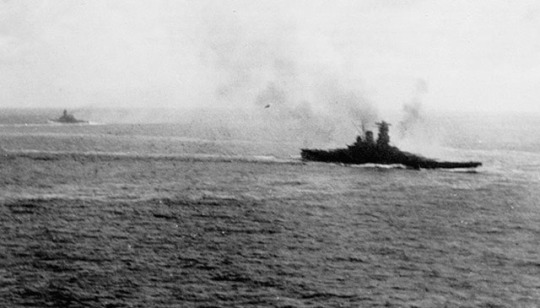
Japanese battleship Yamato conducts evasive maneuvers while under air attack from Taffy 3 aircraft during the Battle off Samar, October 25th, 1944. Another battleship, either Kongo or Haruna, can also be seen maneuvering in the background.
20 notes
·
View notes
Text
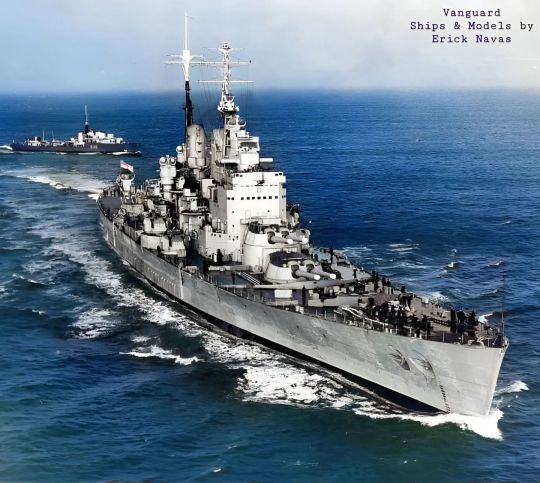
Intended for use in the Pacific, the ship would be fast enough to catch and powerful enough to destroy the Japanese Kongo-class battlecruisers. The design went through several evolutions (at one point the Royal Navy declared that the ship would be a replacement for HMS Royal Oak, sunk by U-47 in 1939) before the keel was finally laid in 1941. Work proceeded slowly, incorporating the lessons of the war, and Vanguard was not finally completed until late 1946. It was the last battleship ever launched, although not the last one completed, an honor that would belong to the French Jean Bart. Displacing 44,500 tons (standard) and capable of thirty knots, Vanguard was the largest battleship ever built by the Royal Navy, and was only exceeded internationally by the Iowa and Yamato classes. However, many of its foreign contemporaries carried a heavier main armament. Vanguard was well armored and an excellent seaboat, but because of its light main battery it likely would have struggled against the Japanese and American super battleships. Visually, its great size made the fifteen-inch turrets look diminutive.
- Robert Farley
24 notes
·
View notes
Text
Japanese kongo class battleship, currently my best and favorite ship to use in world of warships.
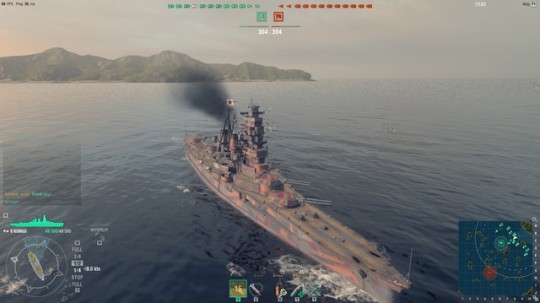
0 notes
Text
Submarines!
What’s going on, friends? I realize it’s been a small fraction of forever since I last updated the Highiary (and it feels longer if you’ve been high), so let’s get around to fixing that, shall we? Summer 2015 isn’t going to document itself!

This was a day where we’d done a big marathon of all six Star Wars movies (two fewer than we have now at the time of my typing this!). I think we started at like 9am over at Doug’s place (with some Skywalker OG because of course) and made a whole day of it.
As I recall we didn’t finish the last movie until like 2am, so clearly having a big bunch of stoned people trying to organize a daylong project while it’s happening isn’t the way do to things. We’ve since done future film days and they’ve all gone a lot smoother (and involved half as many movies).
My reminder here was for me to tweet, the following year, the message indicated therein (which I did remember to do, actually!). If you’re not familiar with that particular phrasing, you should watch this thing here.
(Also those aren’t all shittily drawn Imperial Star Destroyers; I think two of them are shittily drawn Arquitens-class light cruisers.)

Man, I have no idea what was going on this particular day, but I don’t doubt that I was at a [7] given the overall sparse nature of this particular entry.
Wait, why the heck was I at a [7] at lunchtime on a Wednesday? What was going on that day?

For those of you who can’t easily read my handwriting, here are the three salient entries in a running series for this page:
What Am I Doing/Eating?: Eating cold pad see ew out of a carton.
Genius Idea: Not eating any more of this Thai food.
Big Question: Will this make me sick overnight?
I did not get sick overnight, thankfully. I actually remember this whole thing very vividly, including the very moment when I realized that eating cold pad see ew out of a carton in bed at midnight was a really bad idea.
Also that sketch is a silhouette impression of the Kongo-class battleship Haruna of the Imperial Japanese Navy (specifically after it had been rebuilt from a battlecruiser into a fast battleship). Yeah, don’t ask.

This day was a birthday party where I’d been given lots of edibles and also had lots of booze and also also smoked a lot, so come 2am, yeah, I was pretty wiped out, and this entry here shows.
Rodd, as it turns out, is not immune to weed, but for like a year and a half we thought he might be because he kept trying to get high with us but it never worked for some reason. I don’t know what the issue was, but he’s a full-fledged member of Whacky’s circle of stoner-pals at this point, so hey, at least it was a happy ending.
(For those who might be curious, this entry is tagged with a ‘Maybe?’ in my master list as to whether it’s an entry that was written on the periphery of jacking off.)

Man, that submarine doodle is especially sad when compared to the Japanese naval warship sketch just two entries prior. At least I can chalk it up to Whacky just being up to normal form.
Death Star, amusingly enough, not one of the strains we had around on the Star Wars viewing party mentioned earlier. But it’s a nice one! Haven’t run into it in a while. Maybe I should find some to smoke for when I invariably see Rogue One again next.
Also I thiiiink I maybe got laid this night? I don’t know why else I’d mention someone else being around at 1am when I was naked and about to go to bed.
Since I don’t actually remember all that well I’ll just assume that I did, and I’ll also assume that I was good.

Oh look, it’s another doodle of a submarine (if you couldn’t tell)! This one probably falls somewhere in between the previous two doodles in terms of quality, but might fall last in terms of it being obvious what you’re looking at (hint: the horizontal line on the left is meant to represent the horizon line of the sea).
Man, an [8], huh? Looking at what I’d consumed that evening for intoxicants, I suppose it’s not surprising. And oh, look, that same person was also there at an even later time of evening than before, but since I was super high (evidently) I’m again going to assume I had fun sexy times even though I think it seriously might have just been Netflix without the chill.
Next time on the Highiary: some truly, truly incomprehensible doodles, even by Whackberry standards!
3 notes
·
View notes
Text
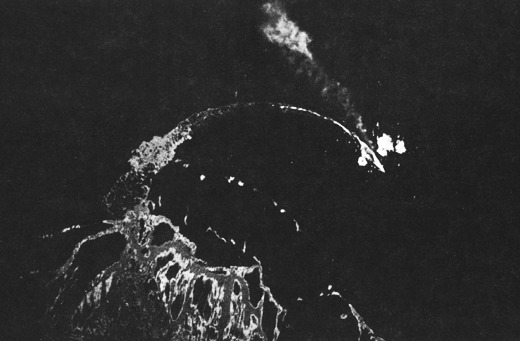
"Boeing B-17 Flying Fortresses of the 11th Bombardment Group based at Espiritu Santo bomb the damaged Japanese Battleship Hiei (比叡, Mount Hiei) north of Savo Island on November 13, 1942. Hiei, which was damaged in the 1st engagement of the Naval Battle of Guadalcanal hours earlier, appears to be trailing fuel."
source
#Japanese Battleship Hiei#Hiei#Kongo Class#Japanese Battleship#dreadnought#battleship#warship#ship#boat#Battle of Guadalcanal#November#1942#World War II#World War 2#WWII#WW2#imperial japanese navy#IJN#my post#Kongō Class
25 notes
·
View notes
Text
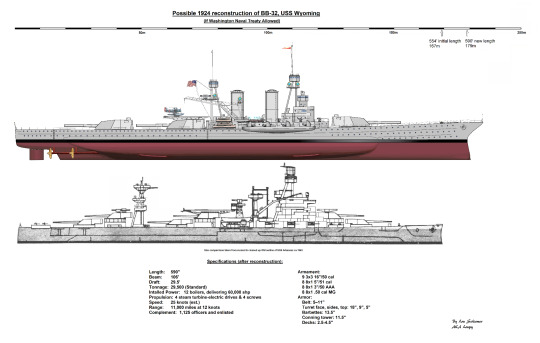
An Alternate History version of USS Wyoming (BB-32), that was rebuilt with three 16 inch gun turrets from the cancelled 1920 South Dakota Class.
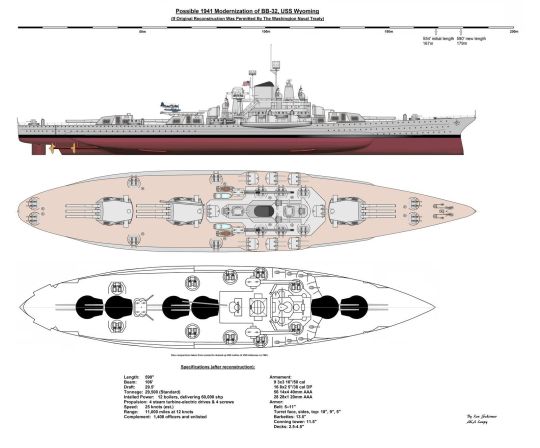
Description from the author:
"I got to thinking about the various modernization programs for battleships between WW1 & WW2. The Washington Naval Treaty was very restrictive though. BUT, what if, in some AU, the wording of Section I, paragraph (d) was changed slightly?
From:
Section I Rules For Replacement
(d) No retained capital ships or aircraft carriers shall be reconstructed except for the purpose of providing means of defense against air and submarine attack, and subject to the following rules: The Contracting Powers may, for that purpose, equip existing tonnage with bulge or blister or antiair attack deck protection, providing the increase of displacement thus effected does not exceed 3,000 tons (3,048 metric tons) displacement for each ship. No alterations in side armor, in calibre, number or general type of mounting of main armament shall be permitted except:
To:
Section I Rules For Replacement
(d) Retained capital ships or aircraft carriers may be reconstructed, subject to the following rules: The Contracting Powers may, for that purpose, equip existing tonnage with bulge or blister or antiair attack deck protection. Modify hulls to improve seaworthiness. Alterations of side armor, calibre, number or general type of mounting of main armament shall be permitted subject to the restriction of 3,000 tons (3,048 metric tons) maximum increase of displacement by all modifications per ship.
That opens up the possibilities. I next looked at battleship classes & picked the Wyoming class as having the most potential. Then what to do, what to do?
I set her first rebuild for the 1924 time frame. There was all this materiel laying around from the cancelled Lexington & South Dakota classes, hmmm. I checked with Springsharp & while they would easily accept the twin 16" turrets from the Lexington class, I got greedy & went with the triple 16" turrets from the South Dakotas. Three triple turrets replaced the six twin turrets she had & the weights would come close to balancing out & increase below deck space for machinery. So I installed a power plant derived from the South Dakotas. Being four years later in construction, the plant should be able to muster 60,000 shp. Instead of lengthening the stern, like the Japanese Kongo class ships, the bow is lengthened to give a finer entry form & increased bouyancy & the stern is rounded out to increase bouyancy. The hull & power modifications should give her about 25 knots speed, reduce pitching & be a test bed for changes to the rest of the fleet. Casemate guns were deleted & replaced with 5"/51 deck guns & 3"/50 AAA on the deck above. The cage masts were replaced by tripods. Side armor was left as is & deck armor increased to 4.5". Deck armor weight increase is balanced by the shorter side belt armor needed with the reduced number of turret barbettes.
This would probably never be done, because you would have to gut the ship & cut off the bow from "B" turret forward. You'd have to completely redesign the interior around the three barbettes. It wouldn't be as expensive as a new ship only because the guns, turrets, barbettes & machinery from the South Dakotas was already paid for. It's still a fun idea though."
This was fun read.
source, source
#USS Wyoming (BB-32)#USS Wyoming#Wyoming Class#Battleship#Dreadnought#Rebuilt#Alternative history#united states navy#us navy#u.s. navy#navy#usn#my post#what if
24 notes
·
View notes